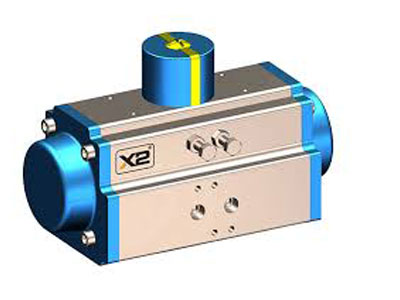What Is The Purpose Of A Rotary Actuator?
Key Takeaway
The purpose of a rotary actuator is to convert energy into mechanical rotation. It generates torque to rotate objects around an axis, enabling controlled angular or oscillating motion. This makes rotary actuators ideal for tasks like opening and closing valves, turning machinery, or positioning equipment in industrial applications.
Rotary actuators are commonly powered by pneumatic, hydraulic, or electric energy. They are compact, durable, and can provide high torque relative to their size. Popular configurations include rack-and-pinion actuators, which use gears for rotation, and vane actuators, which use pressurized vanes to create motion. These actuators simplify system designs, reduce maintenance needs, and are widely used in automation, robotics, and manufacturing processes.
Understanding the role of rotary motion in industrial processes
Rotary motion is a cornerstone of industrial processes, and rotary actuators are the key to achieving this motion efficiently. These actuators provide angular movement, which is essential for tasks like turning, pivoting, or adjusting components in machinery.
Unlike linear actuators, which move objects in a straight line, rotary actuators allow objects to rotate around an axis. This makes them perfect for applications requiring repetitive or continuous rotational movement. Examples include opening and closing valves, rotating robotic joints, or adjusting conveyor systems.
The ability to generate high torque with minimal energy consumption is one of their standout features. This ensures that rotary actuators can handle heavy loads or maintain precise positioning, even in demanding industrial environments.
By enabling controlled rotational movement, rotary actuators form the backbone of many automated systems, ensuring seamless and efficient operations.

Applications of rotary actuators in automation systems
Rotary actuators are a critical component in automation systems, offering precise motion control across a wide range of applications.
Valve Control
Rotary actuators are extensively used in fluid regulation systems to operate ball and butterfly valves. Their ability to provide consistent torque ensures smooth and reliable valve operation, even under high pressure or temperature conditions.
Robotic Systems
In robotics, rotary actuators power joints and enable the multidirectional movement of robotic arms. This allows robots to perform tasks like welding, material handling, and assembly with remarkable accuracy.
Conveyor Systems
Rotary actuators drive rollers and belts in conveyor systems, ensuring smooth movement of goods in manufacturing and logistics operations.
Packaging and Assembly Lines
In packaging processes, rotary actuators handle tasks like sealing, cutting, or labeling with precision and speed. Their efficiency is critical in maintaining the productivity of assembly lines.
By delivering reliable and controlled motion, rotary actuators have become indispensable in automation systems, contributing to enhanced operational efficiency and productivity.
Enhancing precision and efficiency with rotary actuators
One of the standout purposes of rotary actuators is their ability to deliver precision and efficiency in industrial processes.
Precision in Motion
Rotary actuators excel in applications requiring accurate angular adjustments. Their design ensures minimal backlash and consistent performance, making them ideal for tasks like robotic joint movement or valve positioning.
Efficiency in Operation
With the ability to convert minimal energy into high torque, rotary actuators optimize energy usage without compromising on performance. This energy efficiency translates to lower operational costs and reduced environmental impact.
Customizability
Rotary actuators offer adjustable settings for speed, torque, and rotation angle, allowing engineers to fine-tune their operation based on specific requirements. This adaptability ensures optimal performance in diverse scenarios.
Whether it’s achieving precise motion control or maintaining consistent output in demanding conditions, rotary actuators play a crucial role in enhancing efficiency and precision in automation.
Key industries benefiting from rotary actuator integration
Rotary actuators find application across a variety of industries, thanks to their versatility and reliability.
Manufacturing
In manufacturing, rotary actuators are used for tasks like material handling, conveyor operations, and robotic automation. Their ability to handle repetitive tasks with precision makes them invaluable in this sector.
Oil and Gas
Rotary actuators control valves in oil and gas pipelines, ensuring safe and efficient fluid regulation under high pressure and temperature conditions.
Aerospace
In aerospace, rotary actuators are employed in systems like flap controls, landing gear mechanisms, and steering systems, where precision and reliability are paramount.
Automotive
Rotary actuators power steering systems, adjustable seats, and robotic arms in automotive assembly lines, enhancing both functionality and productivity.
Healthcare
In the healthcare sector, rotary actuators are used in diagnostic equipment and surgical robots, enabling precise and controlled movements critical for patient care.
These industries rely on rotary actuators to achieve efficient and precise motion control, showcasing their wide-ranging applicability.
Choosing the right rotary actuator for specific purposes
Selecting the right rotary actuator depends on several factors, including application requirements and environmental conditions.
1. Torque and Load Requirements
Determine the torque needed for the task. Heavy-duty applications, like valve control in oil pipelines, require actuators with high torque capabilities.
2. Rotation Angle
Consider whether the application needs partial or continuous rotation. For example, valve operations typically require a 90° or 180° rotation, while robotic systems may need full 360° motion.
3. Power Source
Choose between pneumatic, hydraulic, or electric rotary actuators based on the power source available and the operational environment.
4. Environmental Conditions
For harsh environments, like offshore platforms or chemical plants, opt for actuators made of corrosion-resistant materials with robust sealing technologies.
5. Precision and Speed
Applications requiring fine angular adjustments, such as robotic arms, benefit from actuators offering high precision and customizable speed settings.
By evaluating these factors, engineers can select the ideal rotary actuator to meet their specific operational needs.
Conclusion
The primary purpose of a rotary actuator is to convert energy into controlled rotary motion, enabling efficient and precise operations in industrial and automation systems. Whether it’s controlling valves, driving conveyor belts, or powering robotic joints, rotary actuators play a critical role in enhancing functionality and productivity.
Their versatility, precision, and efficiency make rotary actuators indispensable across industries, supporting a wide range of applications while ensuring reliable and consistent performance.
